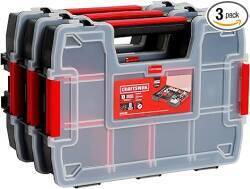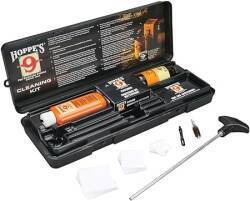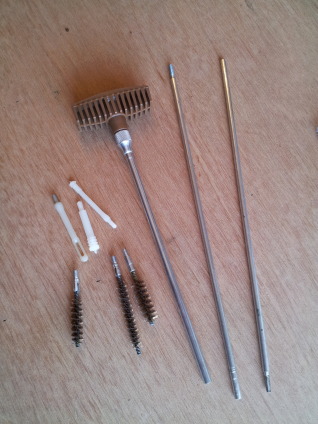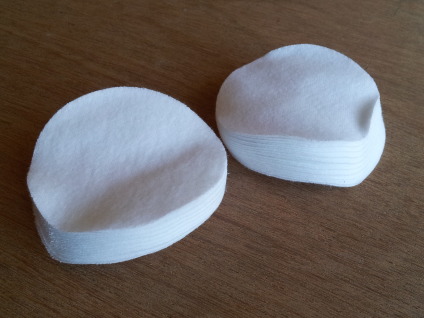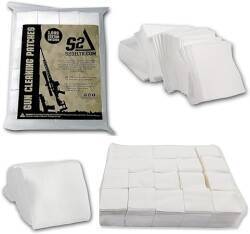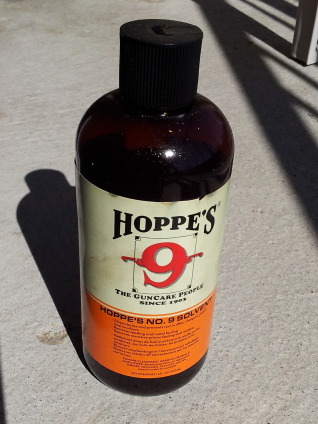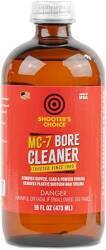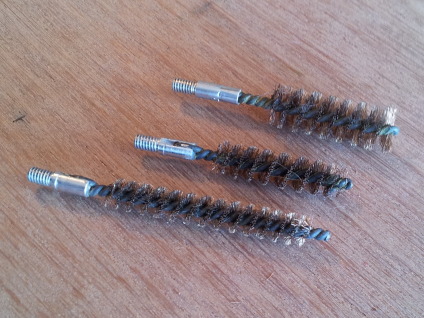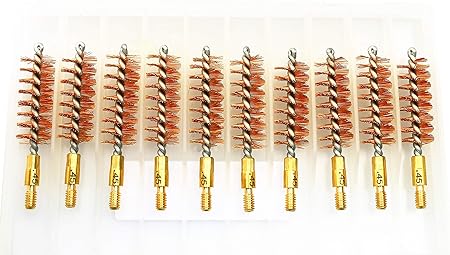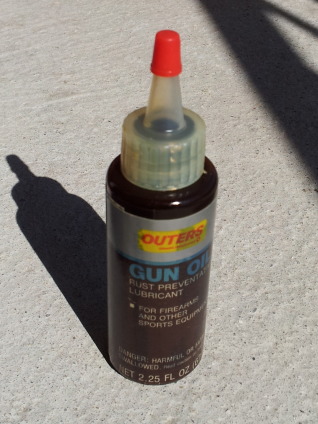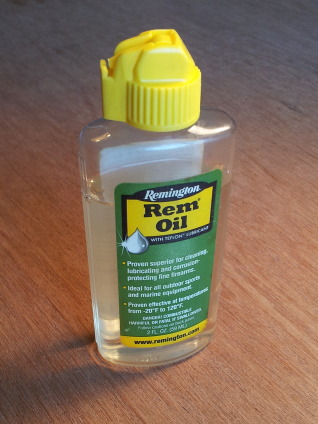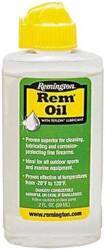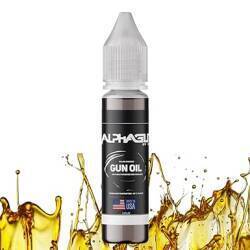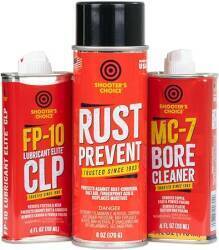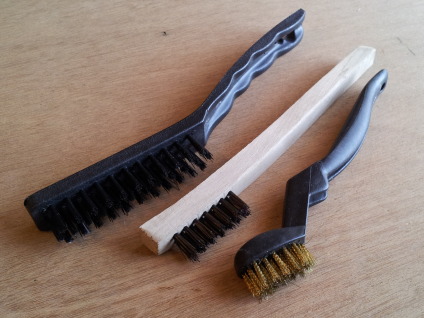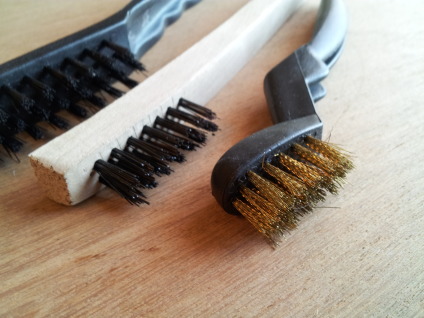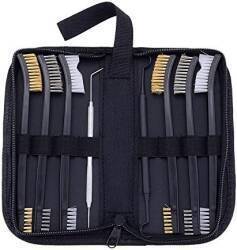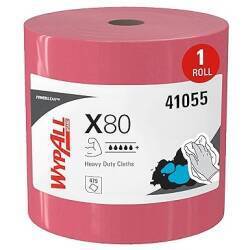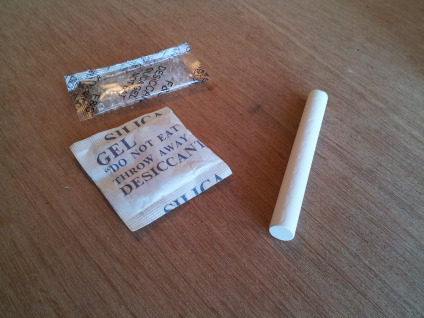
Tools and Supplies for Cleaning Guns
Gun Cleaning Tools and Supplies
Guns are precision devices subjected to harsh conditions of temperature, chemistry, and mechanical operation. You absolutely must clean and lubricate them properly to ensure safe operation. Beyond basic safety, accuracy and reliable operation require careful cleaning. The good news is that several tools and materials are available to make this task easy.
Here is a collection of tools, solvents, and lubricants used to clean and maintain firearms. Let's learn what is involved.
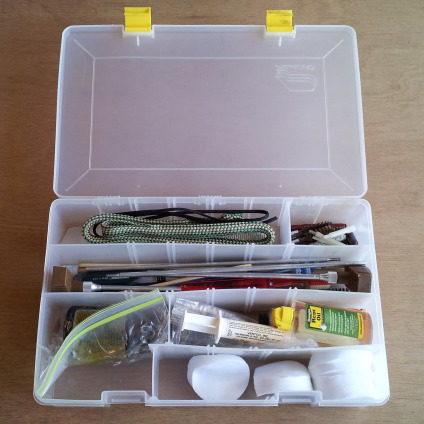
Of course you absolutely must make certain that your gun is unloaded before beginning to clean it.
Besides the obvious safety issues, the solvents and lubricants you are going to use can penetrate around the primer of centerfire cartridges. This damages the ammunition and causes failures to fire or, more dangerous yet, "hangfires" or unpredicatable delays in firing.
There must be no ammunition in your gun cleaning area. Store your ammo separately, and re-verify when you bring a gun into the cleaning area that it is completely unloaded.
Verify that the magazine is empty.
Verify that the chamber is empty.
Check them again.
Now that you are ready and safe, we can proceed.
This is a plastic case with adjustable dividers, commonly sold in hardware stores.
These cases are made of translucent plastic so you can immediately tell what it is. See, this one holds gun cleaning tools and supplies, and not nails and screws, fishing lures, or whatever else you may be storing in cases like these.
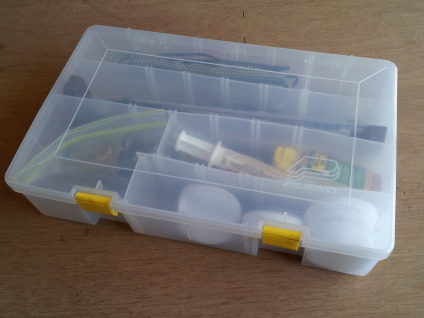
Another advantage is that these cases will hold any oil or solvents spilled within them, as long as you store them laid flat like this.
If a cheap bottle of gun oil leaks, it will make a mess. But at least the mess is kept within this container.
Gun Cleaning Kits
A "big box" store will probably carry basic pistol and rifle gun cleaning kits. Such a kit will include a tee-handled shaft and multiple threaded extensions, plus a variety of threaded tips as seen here.
It will also include a starter set of supplies. Possibly small containers of cleaning solvent and oil, maybe a tube of grease.
A few cotton patches may be included in the basic kit, but you should get a package of them. They are cut to sizes appropriate for ranges of calibers.
Cleaning Solvent
The main work of the cleaning is typically done with a solvent which is somewhat basic and serves to remove the copper, lead, and powder fouling.
| Hoppes #9 | |
| Ingredient | By Weight |
| Ethanol | 15-40% |
| Kerosine | 15-40% |
| Oleic Acid | 15-40% |
| Amyl Acetate | 5-10% |
| Ammonium Hydroxide | 1-5% |
The Material Safety Data Sheet describes Hoppe's Number 9 Gun Bore Cleaner as "a hazardous chemical" as per 29 CFR 1910.1200. It is extremely flammable and its vapor forms an explosive mixture with air. That vapor can travel to a source of ignition and flash back. It is corrosive to skin and mutagenic. Mutagenic means that it changes DNA and increases the rate of mutations. That doesn't mean that it definitely is carcinogenic, but mutagens are very likely to cause cancer.
The Hoppe's logo and the distinctive yellow and orange labels on the brown bottles (now plastic, no longer glass) have a long tradition. It's made by Tri-Pac Inc, of Vandalia, Michigan, and distributed by Bushnell.
Ethanol is grain alcohol, CH3CH2OH.
Kerosine is a petroleum product distilled from crude oil, much less volatile and combustable than the petroleum blends called gasoline. In the 1840s it began to be distilled on an industrial scale and used for heating and light, although the Persian scholar scholar Rāzi had discovered and described the process in the 9th century. It's now used as jet engine fuel.
Oleic acid is a fatty acid found in various animal and vegetable fats and oils. It is the primary component of olive oil.
Amyl acetate is an ester with the fruit-like scent distinctive of that class of chemicals. It's CH3COO(CH2)4CH3.
Ammonium hydroxide is also known simply as ammonia, NH3.
A bronze brush is useful to loosen the heavier fouling. Attach it to the cleaning rod, dip it in the solvent, and run it through the barrel's bore several times. Re-moisten it from time to time.
Ideally, you push it through from the chamber to the muzzle. Then you can unscrew the tip, pull the rod back out the chamber end, and start over. This is quite easy with a typical semi-automatic pistol, as you can partially disassemble it so the barrel is an isolated component. With rifles, however, you will have to work around the attachment of the barrel to the receiver plus any remaining components of the action.
An alternative would be to insert the rod from the muzzle end, thread the tip onto it in the chamber, and pull it down the barrel and out the muzzle end.
The problem with that approach is that the cleaning rod can rub against the muzzle. Any wear at the muzzle can harm accuracy. You can use a muzzle guide to keep the rod away from the muzzle surface. You can also get a cleaning rod coated with soft material.
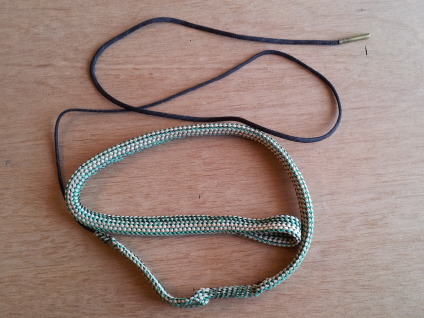
The traditional cleaning method has followed the bronze brush with a series of solvent-soaked patches. You thread the patch through the loop in a plastic cleaning tip and then push or pull that through the barrel bore with the cleaning rod. You continue doing this with a series of solvent-soaked patches until they come out clean.
But with some ammunition, it seems especially so with military surplus, it seems like it is going to take forever for a patch to come out clean. Plus, there's all the passages of the cleaning rod through the bore to worry about.
Enter the bore snake, a clever and fairly simple design.
A brass tip provides weight to pull a small cord down through the barrel, while being much softer than any of gun's parts and so causing no damage.
The brass tip is relatively soft, and after that it's nothing but woven cloth with an embedded bronze brush.
Immediately after the brass tip is enough thin cord to pass completely through the barrel. It's thinner than the bore, so it simply falls through and lets you grasp and pull the tip from the other end.
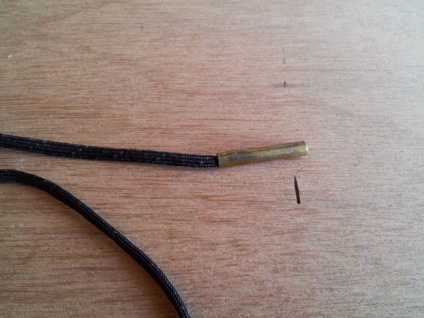
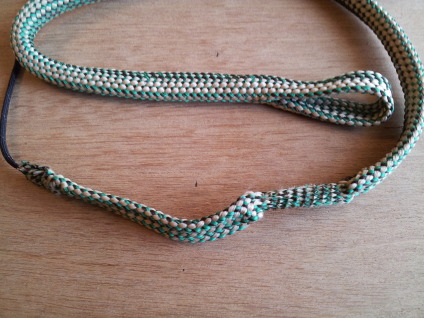
The main "body" of the bore snake is woven cloth that makes for a tight fit within the bore.
A bronze brush is embedded in it.
You fold a segment of the tip or "head" end of the snake and dip it into cleaning solvent. Include the segment with the embedded brush in what you dip.
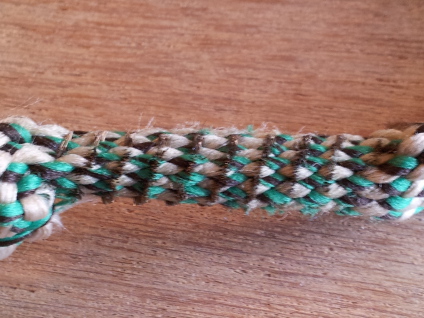
Here you can see the tips of the bronze bristles protruding through the woven cloth of the snake.
Someone told me that they always run their bore snake through with a load of laundry after a cleaning session.
Do not do that unless you want all your clothes to smell like they have been soaked in kerosine!
Also notice the warnings inside the lids of most washing machines warning against laundering oily clothing (or bore snakes) as there is a significant risk of fire.
Now, why does my bore snake look so clean?
I have run it through the dishwasher by itself, but make certain to disable the drying function. You don't want your dishes smelling or tasting of kerosine, so put the bore snake in there by itself. Then you will want to run the dishwasher a second time with plenty of soap but no load.
Lubricants
The all-in-one cleaning kit may come with a small bottle of cleaning solvent.
It may also come with a small bottle of lubricating oil. My experience is that the oil from an all-in-one kit isn't particularly good, and its bottle frequently does not seal well.
Get better lubricating oil. Here is "Rem Oil", Remington's high-quality light-weight oil containing teflon.
Generally speaking, "oil" is lighter weight, less viscous and free-flowing at room temperature, while "grease" is thicker and not a liquid at room temperature.
There is no specific threshold for just what is an oil versus what is a grease, but Rem Oil definitely is a light-weight non-viscous oil.
The conventional wisdom is:
If it rotates, oil it.
If it slides, grease it.
A light-weight oil like Rem Oil will very effectively penetrate between tightly fitting parts, including around pins.
After you have finished with the bore snake (or, long after that, when you have finally finished with the nearly endless series of patches), run a clean cotton patch moistened with light oil like this one through the bore.
If you have Parkerized your guns, those surfaces are slightly porous and can take up and hold even lighter oils like this one.
There are several choices for viscous grease.
Shooter's Choice is a popular one. Its thin nozzle lets you control where you apply it, making it easier to lubricate slide rails.
For overall protection, apply some to a clean dry cloth (like a cleaning patch) and rub the protective lubricant into all surfaces.
Again, Parkerizing is your friend.

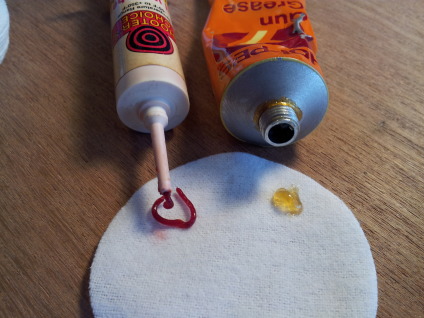
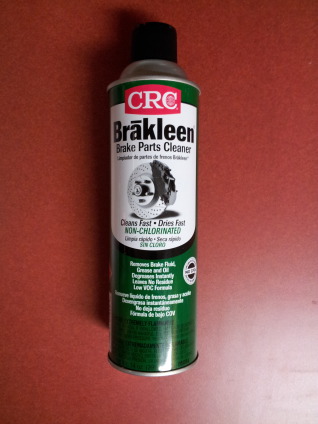
Here's a word of caution about cleaning newly purchased guns for the first time.
Many guns new to you may have some extremely thick grease. Military surplus guns in Cosmoline are an example of this.
You need to remove the Cosmoline, and spray brake cleaner or carburator cleaner from the car-parts store can be very helpful.
However, be careful.
For one thing, these sprays are mostly organic solvents, and they will dissolve or otherwise damage many materials.
Secondly, the chlorinated versions of these are even more dangerous if you go on to heat the metal surface.
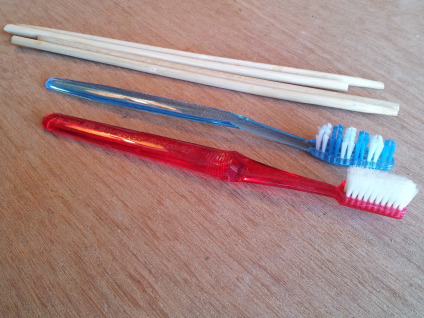
Ordinary Household Tools and Supplies
Used toothbrushes are useful for cleaning tasks.
Bamboo chopsticks are handy for some tasks, especially some of the steps involved in field stripping some guns.
Cotton swaps are handy for cleaning and lubricating steps.
A set of brushes can be very helpful. Set aside any with steel bristles, don't include them in your gun cleaning kit.
A brush with brass bristles is very useful for cleaning. The brass bristles are stiffer than nylon, but the brass is still much softer than any of the metal parts you will be cleaning.
Shop towels are handy, and as they're cheap when purchased in bulk you don't mind discarding soiled ones and always having clean, soft cloth available.
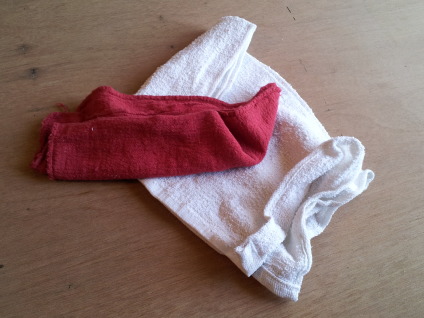
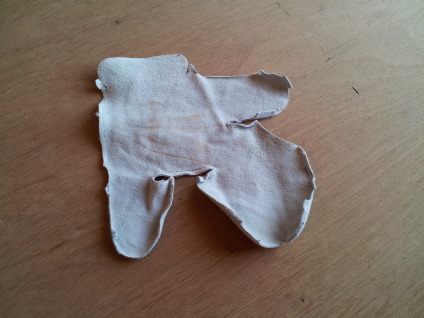
You may need to hold a part of a gun in a vise while working on it.
Purchase a cheap pair of leather-soled work gloves and cut them apart.
Use the leather pieces to protect the parts.
You need to store your guns in a dry environment. You may have a few small desiccant packages from recent purchases. A few sticks of chalk provide a cheap but fairly effective desiccant.
However, get special-purpose desiccant material to really do this right and keep an entire air-tight cabinet or gun safe dry.
I know someone who uses an old refrigerator to store ammunition. It's unplugged, of course! But the refrigerator cabinet with the magnetic rubber strip around the door makes for a nicely air-tight and moisture-resistant container.
A container of desiccant like the one shown here keeps the interior very dry.
